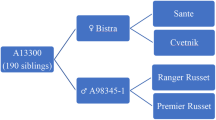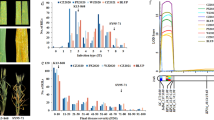Abstract
Key message
We identified, fine mapped, and physically anchored a dominant spot blotch susceptibility gene Scs6 to a 125 kb genomic region containing the Mla locus on barley chromosome 1H.
Abstract
Spot blotch caused by Cochliobolus sativus is an important disease of barley, but the molecular mechanisms underlying resistance and susceptibility to the disease are not well understood. In this study, we identified and mapped a gene conferring susceptibility to spot blotch caused by the pathotype 2 isolate (ND90Pr) of C. sativus in barley cultivar Bowman. Genetic analysis of F1 and F2 progeny as well as F3 families from a cross between Bowman and ND 5883 indicated that a single dominant gene (designated as Scs6) conferred spot blotch susceptibility in Bowman. Using a doubled haploid (DH) population derived from a cross between Calicuchima-sib (resistant) and Bowman-BC (susceptible), we confirmed that Scs6, contributed by Bowman-BC, was localized at the same locus as the previously identified spot blotch resistance allele Rcs6, which was contributed by Calicuchima-sib and mapped on the short arm of chromosome 1H. Using a genome-wide putative linear gene index of barley (Genome Zipper), 13 cleaved amplified polymorphism markers were developed from 11 flcDNA and two EST sequences and mapped to the Scs6/Rcs6 region on a linkage map constructed with the DH population. Further fine mapping with markers developed from barley genome sequences and F2 recombinants derived from Bowman × ND 5883 and Bowman × ND B112 crosses delimited Scs6 in a 125 kb genomic interval harboring the Mla locus on the reference genome of barley cv. Morex. This study provides a foundational step for further cloning of Scs6 using a map-based approach.


Similar content being viewed by others
References
Ameen G, Drader T, Sager L, Steffenson BJ, Kleinhofs A, Brueggeman RS (2016) Rcs5 is a wall associated kinase gene that putatively functions as a dominant susceptibility factor in the barley–Cochliobolus sativus interaction. In: The 12th international barley genetics symposium, 26–30 June 2016, Minneapolis
Bilgic H, Steffenson BJ, Hayes PM (2005) Comprehensive genetic analyses reveal differential expression of spot blotch resistance in four populations of barley. Theor Appl Genet 111(7):1238–1250
Bilgic H, Steffenson BJ, Hayes PM (2006) Molecular mapping of loci conferring resistance to different pathotypes of the spot blotch pathogen in barley. Phytopathology 96(7):699–708
Bovill J, Lehmensiek A, Sutherland MW, Platz GJ, Usher T, Franckowiak J, Mace E (2010) Mapping spot blotch resistance genes in four barley populations. Mol breed 26(4):653–666
Bulgarelli D, Collins NC, Tacconi G, Dellaglio E, Brueggeman R et al (2004) High resolution genetic mapping of the leaf stripe resistance gene Rdg2a in barley. Theor Appl Genet 108:1401–1408
Caldwell KS, Langridge P, Powell W (2004) Comparative sequence analysis of the region harboring the hardness locus in barley and its collinear region in rice. Plant Physiol 136:3177–3190
Castro AJ, Hayes PM, Fillichkin T, Rossi C (2002) Update of barley stripe rust resistance QTL in the Calicuchima-sib × Bowman mapping population. Barley Genet Newsl 32:1–12
Collins NC, Park R, Spielmeyer W, Ellis J, Pryor T (2001) Resistance gene analogs in barley and their relationships to rust resistance genes. Genome 44:375–381
Condon BJ, Leng Y, Wu D, Bushley KE, Ohm RA, Otillar R et al (2013) Comparative genome structure, secondary metabolite, and effector coding capacity across Cochliobolus pathogens. PLoS Genet 9(1):e1003233. https://doi.org/10.1371/journal.pgen.1003233
Dangl JL, Dietrich RA, Richberg MH (1996) Death don’t have no mercy: cell death programs in plant–microbe interactions. Plant Cell 8(10):1793
DeScenzo RA, Wise RP (1996) Variation in the ratio of physical to genetic distance in intervals adjacent to the Mla locus on barley chromosome 1H. Mol Gen Genet 251(4):472–482
Drader TB (2011) Cloning of the seedling spot blotch resistance gene Rcs5. Ph.D. thesis, Washington State University
Faris JD, Zhang Z, Lu H, Lu S, Reddy L, Cloutier S et al (2010) A unique wheat disease resistance-like gene governs effector-triggered susceptibility to necrotrophic pathogens. Proc Natl Acad Sci 107(30):13544–13549
Fetch TG Jr, Steffenson BJ (1994) Identification of Cochliobolus sativus isolates expressing differential virulence on two-row barley genotypes from North Dakota. Can J Plant Pathol 16(3):202–206
Fetch TG Jr, Steffenson BJ (1999) Rating scales for assessing infection responses of barley infected with Cochliobolus sativus. Plant Dis 83:213–217
Franckowiak JD, Foster AE, Pederson VD, Pyler RE (1985) Registration of ‘Bowman’ barley. Crop Sci 25:883
Ganal MW, Tanksley SD (1996) Recombination around the Tm2a and Mi resistance genes in different crosses of Lycopersicon peruvianum. Theor Appl Genet 92(1):101–108
Garvin DF, Brown AHD, Raman H, Read BJ (2000) Genetic mapping of the barley Rrs14 scald resistance gene with RFLP, isozyme and seed storage protein markers. Plant Breed 119:193–196
Grewal TS, Rossnagel BG, Scoles GJ (2012) Mapping quantitative trait loci associated with spot blotch and net blotch resistance in a doubled-haploid barley population. Mol breed 30(1):267–279
Hammond-Kosack KE, Rudd JJ (2008) Plant resistance signaling hijacked by a necrotrophic fungal pathogen. Plant Signal Behav 3(11):993–995
Hanemann A, Schweizer GF, Cossu R, Wicker T, Röder MS (2009) Fine mapping, physical mapping and development of diagnostic markers for the Rrs2 scald resistance gene in barley. Theor Appl Genet 119(8):1507–1522
International Barley Genome Sequencing Consortium (2012) A physical, genetic and functional sequence assembly of the barley genome. Nature 491(7426):711–716
Leng Y, Zhong S (2012) Sfp-type 4-phosphopantetheinyl transferase is required for lysine synthesis, tolerance to oxidative stress and virulence in the plant pathogenic fungus Cochliobolus sativus. Mol Plant Pathol 13:375–387. https://doi.org/10.1111/j.1364-3703.2011.00756.x
Li W, Gill BS (2002) The colinearity of the Sh2/A1 orthologous region in rice, sorghum and maize is interrupted and accompanied by genome expansion in the Triticeae. Genetics 160:1153–1162
Lorang JM, Sweat TA, Wolpert TJ (2007) Plant disease susceptibility conferred by a “resistance” gene. Proc Natl Acad Sci 104(37):14861–14866
Lorang JM, Cuesta-Marcos A, Hayes PM, Wolpert TJ (2010) Identification and mapping of adult-onset sensitivity to victorin in barley. Mol Breed 26:545–550
Lorang JM, Kidarsa T, Bradford CS, Gilbert B, Curtis M, Tzeng SC et al (2012) Tricking the guard: exploiting plant defense for disease susceptibility. Science 338(6107):659–662
Lorieux M (2012) MapDisto: fast and efficient computation of genetic linkage maps. Mol breed 30(2):1231–1235
Mascher M et al (2017) A chromosome conformation capture ordered sequence of the barley genome. Nature 544(7651):427–433
Mathre DE (1997) Compendium of barley diseases, 2nd edn. American Phytopathological Society Press, St. Paul
Mayer KF, Taudien S, Martis M, Šimková H, Suchánková P, Gundlach H et al (2009) Gene content and virtual gene order of barley chromosome 1H. Plant Physiol 151(2):496–505
Mayer KF, Martis M, Hedley PE, Šimková H, Liu H, Morris JA et al (2011) Unlocking the barley genome by chromosomal and comparative genomics. Plant Cell 23(4):1249–1263
Nagy ED, Bennetzen JL (2008) Pathogen corruption and site-directed recombination at a plant disease resistance gene cluster. Genome Res 18(12):1918–1923
Roy JK, Smith KP, Muehlbauer GJ, Chao S, Close TJ, Steffenson BJ (2010) Association mapping of spot blotch resistance in wild barley. Mol Breed 26(2):243–256
Schäfer P, Hückelhoven R, Kogel KH (2004) The white barley mutant Albostrians shows a super susceptible but symptomless interaction phenotype with the hemibiotrophic fungus Bipolaris sorokiniana. Mol Plant Microbe Interact 17(4):366–373
Shahinnia F, Druka A, Franckowiak J, Morgante M, Waugh R et al (2012) High resolution mapping of dense spike-ar (dsp.ar) to the genetic centromere of barley chromosome 7H. Theor Appl Genet 124:373–384
Silvar C, Perovic D, Scholz U, Casas AM, Igartua E, Ordon F (2012) Fine mapping and comparative genomics integration of two quantitative trait loci controlling resistance to powdery mildew in a Spanish barley landrace. Theor Appl Genet 124:49–62. https://doi.org/10.1007/s00122-011-1686-5
Silvar C, Perovic D, Nussbaumer T, Spannagl M, Usadel B, Casas A et al (2013) Towards positional isolation of three quantitative trait loci conferring resistance to powdery mildew in two Spanish barley landraces. PLoS ONE 8(6):e67336. https://doi.org/10.1371/journal.pone.0067336
Silvar C, Martis MM, Nussbaumer T, Haag N, Rauser R, Keilwagen J et al (2015) Assessing the barley genome zipper and the genomic resources for breeding purposes. Plant Genome. https://doi.org/10.3835/plantgenome2015.06.0045
Steffenson BJ, Hayes PM, Kleinhofs A (1996) Genetics of seedling and adult plant resistance to net blotch (Pyrenophora teres f. teres) and spot blotch (Cochliobolus sativus) in barley. Theor Appl Genet 92:552–558
Stirling B, Newcombe G, Vrebalov J, Bosdet I, Bradshaw HD Jr (2001) Suppressed recombination around the MXC3 locus, a major gene for resistance to poplar leaf rust. Theor Appl Genet 103(8):1129–1137
Thomma BP, Nürnberger T, Joosten MH (2011) Of PAMPs and effectors: the blurred PTI-ETI dichotomy. Plant Cell 23(1):4–15
Valjavec-Gratian M, Steffenson BJ (1997a) Pathotypes of Cochliobolus sativus on barley. Plant Dis 81:1275–1278
Valjavec-Gratian M, Steffenson BJ (1997b) Genetics of virulence in Cochliobolus sativus and resistance in barley. Phytopathology 87:1140–1143
Voorrips RE (2002) MapChart: software for the graphical presentation of linkage maps and QTLs. J Hered 93(1):77–78
Wang R, Leng Y, Ali S, Wang M, Zhong S (2017) Genome-wide association mapping of spot blotch resistance to three different pathotypes of Cochliobolus sativus in the USDA barley core collection. Mol Breed 37:44. https://doi.org/10.1007/s11032-017-0626-8
Wei F, Gobelman-Werner K, Morroll SM, Kurth J, Mao L, Wing R et al (1999) The Mla (powdery mildew) resistance cluster is associated with three NBS–LRR gene families and suppressed recombination within a 240-kb DNA interval on chromosome 5S (1HS) of barley. Genetics 153(4):1929–1948
Wei F, Wing RA, Wise RP (2002) Genome dynamics and evolution of the Mla (powdery mildew) resistance locus in barley. Plant Cell 14(8):1903–1917
Wilcoxson RD, Rasmusson DC, Miles MR (1990) Development of barley resistant to spot blotch and genetics of resistance. Plant Dis 74:207–210
Zhong S, Steffenson BJ (2002) Identification and characterization of DNA markers associated with a locus conferring virulence on barley in the plant pathogenic fungus Cochliobolus sativus. Theor Appl Genet 104:1049–1054
Zhong S, Steffenson BJ, Martinez JP, Ciuffetti LM (2002) A molecular genetic map and electrophoretic karyotype of the plant pathogenic fungus Cochliobolus sativus. Mol Plant Microbe Interact 15:481–492
Acknowledgements
The authors thank Joseph Mullins, Zhongxing Sun, Qiang Li, and Yue Zhou for assistance in greenhouse phenotyping experiments. This research was funded by the Triticeae-CAP project (2011-68002-30029) of the US Department of Agriculture National Institute of Food and Agriculture.
Author information
Authors and Affiliations
Corresponding author
Ethics declarations
Ethical standards
The authors state that all experiments in the study comply with the ethical standards in the USA.
Conflict of interest
The authors claim that there is no conflict of interest.
Additional information
Communicated by Xiaoquan Qi.
Electronic supplementary material
Below is the link to the electronic supplementary material.
Rights and permissions
About this article
Cite this article
Leng, Y., Zhao, M., Wang, R. et al. The gene conferring susceptibility to spot blotch caused by Cochliobolus sativus is located at the Mla locus in barley cultivar Bowman. Theor Appl Genet 131, 1531–1539 (2018). https://doi.org/10.1007/s00122-018-3095-5
Received:
Accepted:
Published:
Issue Date:
DOI: https://doi.org/10.1007/s00122-018-3095-5




